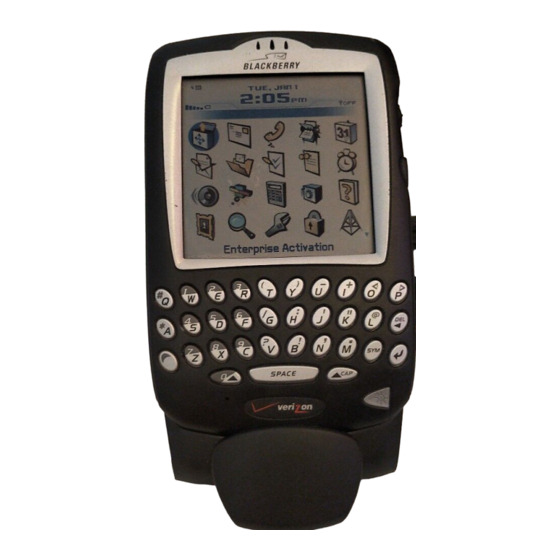Blackberry 7750 Bezpieczeństwo i informacje o produkcie - Strona 6
Przeglądaj online lub pobierz pdf Bezpieczeństwo i informacje o produkcie dla Urządzenia przenośne Blackberry 7750. Blackberry 7750 10 stron. Blackberry wireless handheld
Również dla Blackberry 7750: Podręcznik dla początkujących (13 strony), Podręcznik dla początkujących (2 strony), Podręcznik dla początkujących (13 strony)

Safety and Product Information Booklet
Failure to observe all safety instructions contained in the user documentation for the handheld will
void the Limited Warranty and might lead to suspension or denial of services to the offender, legal
action, or both.
Additional safety guidelines
Liquids and foreign objects: Never push objects of any kind into the handheld or handheld
accessories through openings as this action might short circuit parts and cause a fire or electric shock.
Do not use the handheld or handheld accessories near water (for example, near a bathtub or a sink, in a
wet basement, or near a swimming pool). Never spill liquid of any kind on the handheld or handheld
accessories.
Stability: Do not place the handheld or handheld accessory on any unstable surface. It could fall,
thereby potentially causing serious injury to a person and serious damage to the handheld or handheld
accessory. Take care when using the handheld with any charging accessories to route the power cord in
a way that reduces the risk of injury to others, such as by tripping or choking.
Cleaning: Do not use liquid, aerosol cleaners, or solvents on or near the handheld or handheld
accessory. Clean only with a dry cloth. Disconnect any cables from the computer and unplug any
charging accessories from the electrical outlet before cleaning either the handheld or the charging
accessory.
Compliance information
Exposure to radio frequency signals
The BlackBerry Wireless Handheld is a low power radio transmitter and receiver. When the handheld
radio is on, it receives and also sends out RF signals. The handheld complies with U.S. Federal
Communications Commission (FCC) and Industry Canada (IC) guidelines respecting safety levels of
RF exposure for wireless handheld devices, which in turn are consistent with the following safety
standards previously set by Canadian, U.S., and international standards bodies:
• ANSI/IEEE C95.1, 1999, IEEE Standard for Safety Levels with Respect to Human Exposure to Radio
Frequency Electromagnetic Fields, 3 kHz to 300 GHz
• National Council on Radiation Protection and Measurements (NCRP) Report 86, 1986, Biological
Effects and Exposure Criteria for Radio Frequency Electromagnetic Fields
• Health Canada, Safety Code 6, 1999, Limits of Human Exposure to Radio Frequency
Electromagnetic Fields in the Frequency Range from 3 kHz to 300 GHz
• International Commission on Non-Ionizing Radiation Protection (ICNIRP), 1998, Guidelines for
limiting exposure to time-varying electric, magnetic, and electromagnetic fields (up to 300 GHz)
To maintain compliance with FCC and IC RF exposure guidelines, when carrying the handheld on
your body, use RIM-supplied or approved accessories, or accessories that contain no metallic
components and provide a separation distance from the body of at least 15 mm (0.60 inches). Use of
other accessories might violate FCC and IC RF exposure guidelines and might void any warranty
applicable to the handheld. For data operation (when you do not use a body-worn accessory and are
not holding the handheld at the ear), position the handheld at least 15 mm (0.60 inches) from the body.
Specific absorption rate data
THIS MODEL WIRELESS HANDHELD MEETS GOVERNMENT REQUIREMENTS FOR EXPOSURE
TO RADIO WAVES.
The BlackBerry Wireless Handheld is a radio transmitter and receiver. It is designed and manufactured
not to exceed the emission limits for exposure to radio frequency (RF) energy set by the Federal
Communications Commission (FCC) of the U.S. Government and Industry Canada of the Canadian
Government (IC). These limits are part of comprehensive guidelines and establish permitted levels of
6
